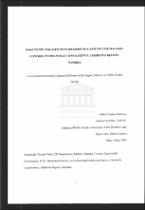| dc.contributor.advisor | Gouws, Marius | |
| dc.contributor.author | Matengu, Castro | |
| dc.date.accessioned | 2022-09-06T07:23:31Z | |
| dc.date.available | 2022-09-06T07:23:31Z | |
| dc.date.issued | 2005 | |
| dc.identifier.uri | http://hdl.handle.net/11394/9289 | |
| dc.description | Magister Public Health - MPH | en_US |
| dc.description.abstract | purpose;To assess and determine insecticide treated nets (ITNs) distribution and use for malaria intervention in Omuntele Constituency
Study Design: Cross-sectional analyical household KAP survey' Sample:6 out of 35 villages in Omuntele Constituency in Oshikoto Region (Northwest Namibia) were selected. 10 households each were selected randomly from 6 villages as the primary sample unit (PSU).
Respondents: A random sample of 60 male and 60 female adults above 15 years of age. Data collection and analysis: A standardized questionnaire was administered to a sample of 120 respondents of 60 households of selected villages. Data was analyzed by using
CSAMPLE in Epi lnfo 2002 for the estimation of frequencies. Results: The results showed a proportion of 50% of households surveyed owned more than one net and 23.3Yo had at least one net, leaving 26.7oh that did not have a net at all' A mean of 1.8 nets per household was observed. More than one third (36.6 %) of people living in the investigated households were sleeping under a net with 31.3% of them
having been children less than five years of age. Availability of money, educational status and close distance of households to net sales points were the main contributing factors for net ownership. The generally high willingness to pay for ITNs was often not compatible with the ability to pay. Respondents were much more knowledgeable than expected about malaria in general but could often not answer more specific questions regarding prevention and individual protection. 85.2o/o of net owners used their nets regularly at least during malaria season while inconvenience and discomfort caused by heat and stuffiness were the main reasons given by those for not, or not regularly, using their
ITNs. Conclusion: Financial constraints remain the main barrier of increasing ITN coverage. Providing ITNs free of charge would be a viable way to maintain equity and guarantee an immediate increase in access. The changing epidemiology of malaria in Namibia, and indeed the whole world, expresses the need to enhance control strategies with non-traditional interventions. The use of insecticide treated nets (ITNs), as a means of recruiting community participation into malaria control, has been tried elsewhere [1]. However, very little is currently
operational in Namibia, where active community participation in malaria control has been widely implemented and assessed. Therefore, this study assessed the level of ITN distribution and use as a participative means of malaria control in the community of Omuntele. With approximately 400 000 clinical cases of malaria and between 300-500 deaths every year, malaria ranks first in terms of morbidity in Namibia, and third in mortality, following HIV/AIDS and tuberculosis [2]. The majority of these cases occur in the northern parts of the country. Plasmodiumfalciparum,the most dangerous and fatal of the four malaria parasite species, accounts for 97o/o of all malaria infections in Namibia[2]. The country experiences seasonal unstable malaria transmission characteized by sporadic epidemics of severe disease whose incidence are greatly influenced by the rainfall pattems. The peak transmission period is usually from February to April. Malaria is endemic in the northern regions of the country [3]. | en_US |
| dc.language.iso | en | en_US |
| dc.publisher | University of the Western Cape | en_US |
| dc.subject | Malaria Indoor Residual House Spray Programme (MIRHSP) | en_US |
| dc.subject | Primary Health Care (PHC) | en_US |
| dc.subject | Global Malaria Control Strategy (GMCS) | en_US |
| dc.subject | Insecticide Treated Nets (ITNs) | en_US |
| dc.subject | Namibia | en_US |
| dc.subject | Oshakati District | en_US |
| dc.title | Insecticide treated nets distribution and use for malaria control in Omuntele Constituency, Oshikoto Region, Namibia | en_US |
| dc.rights.holder | University of the Western Cape | en_US |

